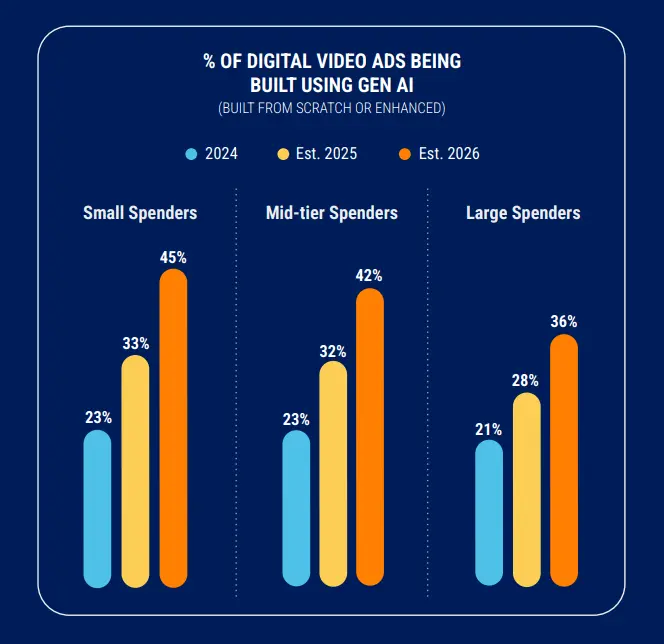- 30% of digital video ads used GenAI in 2024; expected to reach 39% by 2026
- Small brands project 45% AI-built creatives by 2026, versus 36% for large advertisers
- Top GenAI use cases include script development, versioning, and voiceover synthesis
- 90% of buyers use or plan to use GenAI, with strong emphasis on human oversight
- Marketers should build AI playbooks, invest in training, and rigorously measure AI-driven performance
According to the Interactive Advertising Bureau’s (IAB) July 2025 Digital Video Ad Spend & Strategy report, 30% of digital video ads in 2024 were either built from scratch or enhanced using generative AI—and buyers expect that share to climb to 39% by 2026, reflecting rapid mainstreaming of AI‑driven creative workflows.
Unprecedented Uptick in AI‑Driven Creative
The IAB’s survey of 368 senior ad‑spend decision‑makers reveals that nearly one‑third of all digital video creatives today leverage GenAI tools—such as ChatGPT, Gemini, Synthesia, and Runway—for scripting, storyboarding, or post‑production augmentation.
This marks a decisive shift from experimental pilots to production‑scale deployment: whereas just 22% of buyers reported GenAI usage in 2023, 30% did so in 2024, and 39% anticipate using it by 2026.

Source: IAB
Analysts attribute this rapid ascent to three factors:
- Speed & Scalability: GenAI can generate multiple script variants, voice‑over tracks, and even rudimentary animations in minutes—transforming workflows that once took days or weeks.
- Cost Efficiency: Brands with limited budgets or lean creative teams can bypass traditional production hurdles, using AI to prototype and iterate at a fraction of the cost.
- Data‑Driven Personalization: By integrating audience insights directly into AI prompts, marketers produce tailored versions of ads optimized for demographics, geographies, or purchase intent—without re‑shooting footage.
Small Brands Leading the Charge
SMBs are outpacing larger enterprises in AI adoption. The IAB finds that 45% of digital video ads from small‑spender brands (<$10 M annual video budgets) will be AI‑built by 2026—compared to 36% among the largest advertisers (> $50 M budgets). Midsize brands fall in between, forecasting 42% AI‑driven creative by the same year.

Source: IAB
This disproportionate uptake reflects smaller brands’ need to maximize limited resources. For these advertisers, GenAI not only accelerates asset creation but also democratizes access to advanced editing and visual effects—capabilities historically reserved for deep‑pocketed agencies.
The report notes that SMBs cite “faster turnaround” and “affordable prototyping” as their top GenAI benefits, underscoring AI’s role in leveling the creative playing field.
How Buyers Are Using GenAI Today
Buyers report applying GenAI across the video production lifecycle:
- Script & Copy Development: Generating initial script drafts and on‑brand messaging frameworks.
- Visual Style & Storyboarding: Creating mood boards and style frames to guide human editors.
- Audio Enhancement: Synthesizing voiceovers in multiple languages and adjusting tone to match campaign sentiment.
- Versioning & A/B Testing: Rapidly producing multiple cuts to test different creative hooks, CTAs, and promotional offers.
The IAB report highlights “audience versioning” as the most common GenAI application, enabling precise message tailoring through programmatic insertion of text, visuals, or audio variants.
Industry Perspectives & Cautions
As generative AI cements its role in video‑ad production, the IAB report underscores both widespread enthusiasm and a clear mandate for accountability among buyers.
Key insights include:
- Near‑Universal Adoption: Nearly nine in ten digital‑video buyers are already using—or planning to use—GenAI tools for creative production, signaling that AI has moved from pilot projects to mainstream workflows.
- Audience Versioning Leads Use Cases: Customizing ads for different audience segments is the top GenAI application (42% of buyers), highlighting the value of rapid personalization without reshooting footage.
- Demand for Sell‑Side Facilitation: 46% of buyers want publishers and platforms to actively facilitate GenAI creative testing, leveraging platform data and insights to inform AI‑driven concepts and streamline experimentation.
- Human‑in‑the‑Loop Oversight: 37% of respondents cite the "need for sell‑side partners" to offer human review and sign‑off processes, ensuring that AI outputs align with brand voice and quality standards.
- Compliance & Brand Safety Support: 32% of buyers expect platforms to provide compliance guidance and brand‑safety checks for AI‑generated assets, safeguarding against regulatory missteps and reputational risk.
- Performance Transparency: 32% insist that sell‑side partners ensure clear visibility into which AI models and prompt variants drive the best engagement metrics, enabling data‑driven optimization of AI‑produced creative.
These findings illustrate that, while GenAI unlocks speed and scale, buyers are equally focused on governance—seeking robust frameworks for human oversight, compliance, and transparent performance measurement.
Strategic Imperatives for Marketers
To harness GenAI effectively, senior social media and influencer marketing professionals should:
- Develop an AI‑First Creative Playbook: Establish clear guidelines on when and how to apply GenAI—defining roles for AI versus human collaborators, setting prompt standards, and documenting revision workflows.
- Invest in Training & Tool Integration: Equip teams with hands‑on GenAI training and integrate AI platforms (e.g., Synthesia for video avatars, Runway for editing) into existing creative suites to streamline handoffs and asset management.
- Measure AI‑Driven Impact: Implement experiments that compare AI‑produced versus traditionally produced video performance—tracking metrics such as view‑through rates, click‑through rates, and post‑view conversion lift.
- Balance Speed with Quality: Use GenAI to accelerate low‑risk tasks (e.g., variant generation or localization), while reserving high‑stakes content (e.g., flagship brand stories) for more thorough human refinement.
Looking Ahead: GenAI’s Next Frontier
As GenAI tools mature—incorporating advanced video synthesis, real‑time personalization, and deeper integration with ad‑tech stacks—the share of AI‑driven creatives is poised to exceed 50% by 2027.
However, the real battle will be over human‑AI collaboration: brands that blend AI’s efficiency with human creativity, ethics, and strategic oversight will achieve the greatest competitive advantage.



